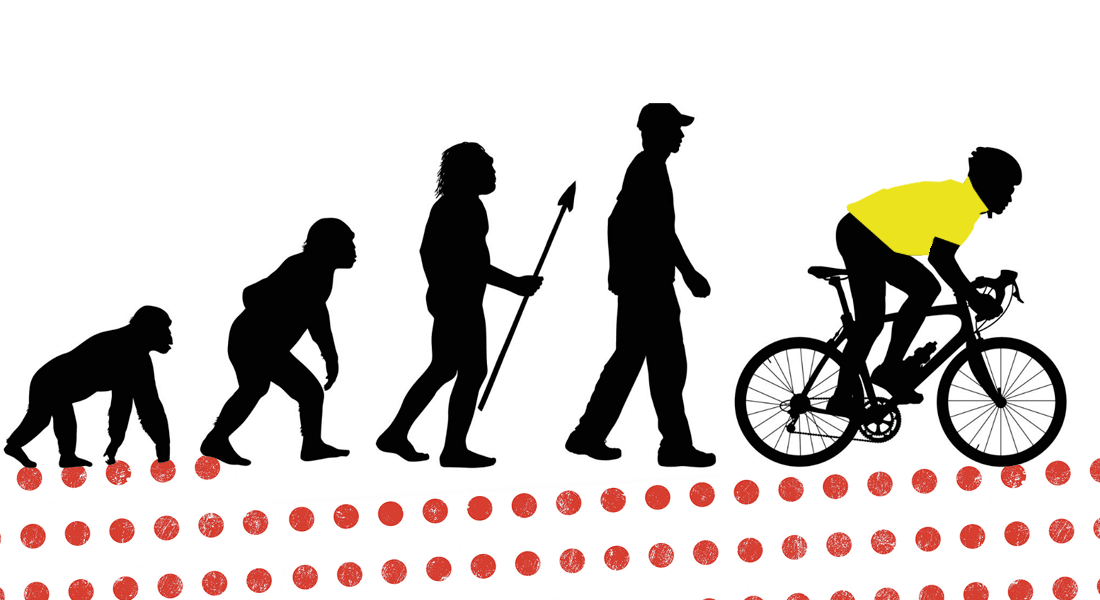Perspiration and an ingenious suspension prepared early humans for the yellow jersey
Unparalleled endurance allowed Homo erectus to tire antelopes on the savannah two million years ago. Since then, our prehistoric genetics have been leveraged to compete in the world's toughest bike race. The Tour de France is the ultimate test of our genes, because over long distances, humans are one of the animal kingdom’s best performing species.

To see elite athletes excelling at their sport is always impressive. But to truly put our physical abilities to the test, we need to hold them up against the animal kingdom as a whole. Here, we have to admit that human achievement often pales in comparison to that of other species. A cheetah, and even a bear cub, can outrun Usain Bolt in the 100-meter dash. And, imagine competing with a spider monkey in gymnastics!
But according to Peter C. Kjærgaard, Director of the Natural History Museum of Denmark and an expert in human evolutionary history, there is one area where humans have excelled for millions of years: Endurance over long distances.
"Whenever we see cyclists battling their way up Alpe d'Huez or other grueling stretches of the Tour De France, we admire them as exceptional athletes. And they are – but we're actually built for it. This trait extends back to Homo erectus, an ancestral species of modern humans,” explains Peter C. Kjærgaard.
By about 1.8-2 million years ago, Homo erectus had developed a body adapted to travel long distances, which made it possible to exploit a niche in the ecosystem that other predators could not: They could follow prey for longer than other predators, which were typically faster hunters, but as we know from the big cats of the African savannah, had nowhere near as much endurance.
“Homo erectus could compete with faster predators by continuing to run when others would quit. At some point, the antelope, or whatever prey Homo erectus was after, had to stop, rest and rid itself of excess heat. This is when erectus closed in,” explains Peter C. Kjærgaard.
Unique sweat transport and a solid suspension
The key to humans being able to beat other animals over the long haul lies in our ability to regulate heat. Homo erectus had a unique sweat transport mechanism – that could cool the body – which made it superior to other animals. And the ability to secrete sweat only got better as fur from their ape ancestry grew thinner and thinner.
Whenever we see cyclists battling their way up Alpe d'Huez or other grueling stretches of the Tour De France, we admire them as exceptional athletes. And they are – but we're actually built for it.
Our need to get rid of surplus heat is a characteristic that we share with all mammals. However, many other mammals get rid of heat by opening their mouths and sticking their tongues out, like a panting dog.
"They need to stop in order to do so, because they can't run and have their tongue out at the same time. We needn’t do so, nor did Homo erectus, because our fantastic sweat glands allow us to get rid of heat. This means that we don’t need breaks in the same way and can keep running. That’s what makes it possible for us to cycle on and on today,” says Peter C. Kjærgaard.
Besides sweat glands, we also inherited unique skeletal and biomechanical features from Homo erectus. These let Homo erectus run distances without mechanical wear and tear of the body.
“The perfectly adapted human body and suspension we inherited from Homo erectus is the prerequisite for modern humans being able to ride for as long as Tour De France cyclists do,” says Peter C. Kjærgaard.
The biomechanical features that we inherited have also been a decisive factor over the past few million years with regards to the development of a brain so inventive that it has landed us on the moon, is considering taking animals off the menu again, and not least, created the bike itself – on which our finest long-distance athletes are now attacking thousands of kilometers of road and each other like predators on the savannah, for the sake of sport and entertainment. Now that’s surplus energy. Take that "mammals"!
Facts: Inheritance from Homo erectus
Heat – We have an exceptional ability to sweat and give off heat. While other mammals need to stop and slowly exhale excess heat, we can cool down while moving.
Body as Spring – From the forefoot to the Achilles' heel, from the knee to the hip and on up our spine, the human body is designed to run. And because we only use two legs – a lot of energy is saved.
Off with the Fur Coat – fur-free bodies let us get rid of heat even faster.
The Brain – Scientific researchers believe that human brain development required access to large amounts of energy. The first great leap came with Homo erectus, who mastered getting meat by long-distance running, and, moreover, learned how to cook it over fire. This allowed the brain to grow, which is how we figured out how to build and use tools – and even carbon racing bikes!
Contact
Contact
Peter C. Kjærgaard
Museum Director and Professor of Evolutionary History
The Natural History Museum of Denmark
University of Copenhagen
Mail: kjaergaard@snm.ku.dk
Kristian Bjørn-Hansen
Journalist
Faculty of Science
University of Copenhagen
Mail: kbh@science.ku.dk
+45 93 51 60 02
